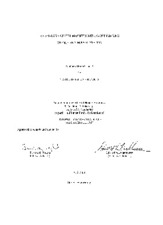| dc.creator | Kremkus, Mark Christian | |
| dc.date.accessioned | 2013-02-22T20:41:41Z | |
| dc.date.available | 2013-02-22T20:41:41Z | |
| dc.date.created | 2001 | |
| dc.date.issued | 2013-02-22 | |
| dc.identifier.uri | https://hdl.handle.net/1969.1/ETD-TAMU-2001-Fellows-Thesis-K72 | |
| dc.description | Due to the character of the original source materials and the nature of batch digitization, quality control issues may be present in this document. Please report any quality issues you encounter to digital@library.tamu.edu, referencing the URI of the item. | en |
| dc.description | Includes bibliographical references (leaf 32). | en |
| dc.description.abstract | The goal of PERL MRI in its most basic form is single shot imaging without the need to rapidly switch gradients to encode spatial information into the signal. PERL MRI incorporates the application of the PERL field into the standard spin echo sequence following the excitation of spins, creating an initial phase pattern that causes echoes to form in the signal in the presence of a constant readout gradient. The echo train that occurs can be sampled and decoded into image data using reconstruction methods that are not discussed in this paper. The theoretical analysis of PERL MRI that will be discussed verifies the mathematical basis for the formation of a periodic signal resulting from cyclical coherence of the spins within a homogeneous sample. Theory also indicates a significant reduction in the maximum amount of coherence present in the PERL signal as compared to total coherence that occurs at the center of k-space, indicating that SNR may suffer with this technique. The effects of specific design parameters on the field generated by a proposed PERL coil design layout is discussed, and an experimental design is presented. The experimental PERL coil produces an approximation of the PERL field over a limited spatial region at the center of the coil structure. The PERL MRI pulse sequence was implemented by interfacing the experimental PERL coils to the slice selection gradient channel of a TecMag MRI console. Experiments were conducted using water phantom with varying amounts of PERL prephasing and readout gradient strengths, in an attempt to obtain data confirming the effects of the PERL imaging parameters on the PERL signal. These experiments were inconclusive as to the formation of a PERL echo train, but some form of cyclical coherence appeared to result. The evidence does not suggest that the PERL approach is robust when implemented with the experimental apparatus used in these experiments. Additional experiments are proposed, and possible explanations for the non-ideality of the experimental results are presented. | en |
| dc.format.medium | electronic | en |
| dc.format.mimetype | application/pdf | |
| dc.language.iso | en_US | |
| dc.publisher | Texas A&M University | |
| dc.rights | This thesis was part of a retrospective digitization project authorized by the Texas A&M University Libraries in 2008. Copyright remains vested with the author(s). It is the user's responsibility to secure permission from the copyright holder(s) for re-use of the work beyond the provision of Fair Use. | en |
| dc.subject | engineering. | en |
| dc.subject | Major engineering. | en |
| dc.title | An analysis of the PERL Magnetic Resonance Imaging theory and implementation | en |
| thesis.degree.department | engineering | en |
| thesis.degree.discipline | engineering | en |
| thesis.degree.name | Fellows Thesis | en |
| thesis.degree.level | Undergraduate | en |
| dc.type.genre | thesis | en |
| dc.type.material | text | en |
| dc.format.digitalOrigin | reformatted digital | en |


